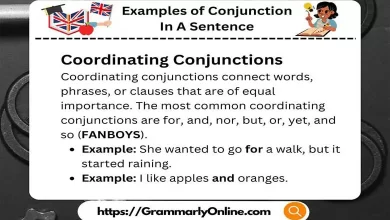What are 7 Coordinating Conjunctions? List & Examples
In the intricate web of the English language, coordinating conjunctions play a pivotal role in linking words, phrases, and clauses. These linguistic connectors enable smooth transitions and coherent sentence structures, ensuring our communication is both effective and fluid. Understanding the function and application of coordinating conjunctions is essential for mastering English grammar.
Understanding Coordinating Conjunctions
Coordinating conjunctions are words that join two or more elements of equal grammatical importance. These elements could be words, phrases, or independent clauses. The seven coordinating conjunctions in English can be remembered using the acronym FANBOYS: for, and, nor, but, or, yet, so. Each of these conjunctions serves a specific purpose and adds distinct meaning to the sentences they connect.
List of Coordinating Conjunctions
1. For
For is used to explain reasons or purposes. It introduces a cause or reason, making it synonymous with “because” in some contexts.
Example:
- She stayed at home, for she was feeling unwell.
- He turned off the lights, for he wanted to save electricity.
2. And
And is the most common coordinating conjunction, used to add or link similar ideas or elements. It denotes addition and can connect words, phrases, or independent clauses.
Example:
- I bought apples and oranges.
- She sings beautifully and dances gracefully.
3. Nor
Nor is used to present an additional negative idea to a previously stated negative idea. It is often paired with “neither” to link two negative clauses.
Example:
- She neither smiled nor spoke during the meeting.
- He doesn’t like spinach, nor does he enjoy broccoli.
4. But
But introduces a contrast or exception. It connects ideas that are opposites or significantly different.
Example:
- I wanted to go to the beach, but it started raining.
- She is talented, but she lacks confidence.
5. Or
Or presents alternatives or choices between two or more options. It is essential in forming questions and conditional statements.
Example:
- Would you like tea or coffee?
- You can start now, or you can wait until later.
6. Yet
Yet introduces a contrasting idea that follows logically from the previous statement. It is similar to “but” but often suggests a stronger or more surprising contrast.
Example:
- He studied hard, yet he failed the exam.
- The book is old, yet it remains popular.
7. So
So indicates a result or consequence. It connects an action with its result or an effect with its cause.
Example:
- It was late, so they decided to leave.
- She missed the bus, so she took a taxi.
Detailed Examples and Usage
Using “For” in Sentences
“For” is less commonly used in modern English compared to other coordinating conjunctions but remains significant in formal writing.
Example Sentences:
- The children went to bed early, for they were tired from the day’s activities.
- He packed an extra jacket, for the weather was unpredictable.
Using “And” in Sentences
“And” can link various grammatical elements, making sentences more dynamic and informative.
Example Sentences:
- She likes to read books and listen to music.
- The project was challenging and rewarding.
Using “Nor” in Sentences
“Nor” is used in a negative context, often following “neither.”
Example Sentences:
- Neither the manager nor the assistant was available.
- He did not understand the instructions, nor did he ask for help.
Using “But” in Sentences
“But” effectively introduces contrast, highlighting differences or exceptions.
Example Sentences:
- She is friendly, but she can be very stubborn.
- He wanted to buy the car, but he couldn’t afford it.
Using “Or” in Sentences
“Or” is vital in presenting choices and options, making it crucial in both everyday and formal contexts.
Example Sentences:
- You can have pasta or pizza for dinner.
- Should we walk or take a cab?
Using “Yet” in Sentences
“Yet” introduces surprising contrasts, often highlighting unexpected outcomes.
Example Sentences:
- She is petite, yet she is incredibly strong.
- The solution seemed simple, yet it was very effective.
Using “So” in Sentences
“So” connects actions with their outcomes, clarifying cause-and-effect relationships.
Example Sentences:
- The team worked overtime, so they finished the project early.
- He didn’t study, so he failed the test.
Common Mistakes with Coordinating Conjunctions
1. Overusing “And”
Using “and” excessively can make sentences monotonous. It’s essential to vary sentence structures to maintain reader interest.
Example:
- Overused: She likes to run, and swim, and bike, and hike.
- Improved: She enjoys running, swimming, biking, and hiking.
2. Misplacing “But” and “Yet”
“But” and “yet” should correctly link contrasting ideas. Misplacement can lead to confusing or incorrect sentences.
Example:
- Incorrect: He is tired but, he continues to work.
- Correct: He is tired, but he continues to work.
3. Incorrect Use of “Nor”
“Nor” should follow a negative clause, and it should be paired with “neither” for correct usage.
Example:
- Incorrect: He didn’t call me nor text me.
- Correct: He neither called me nor texted me.
Conclusion
Coordinating conjunctions are indispensable tools in constructing coherent, engaging, and grammatically correct sentences. Mastering the use of for, and, nor, but, or, yet, so not only enhances writing clarity but also enriches the overall quality of communication. By understanding the specific roles and proper applications of these conjunctions, we can significantly improve our writing and ensure that our ideas are conveyed with precision and fluency.

